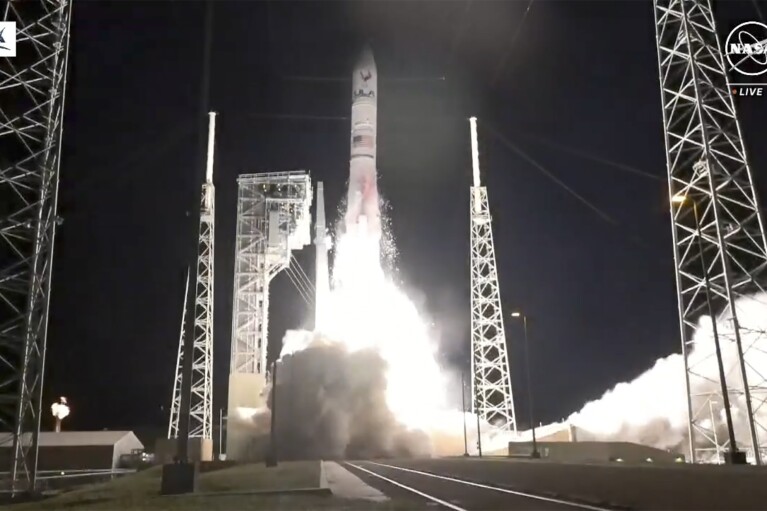[ad_1]
CAPE CANAVERAL, Florida (AP) — The first U.S. lunar lander in more than 50 years blasted off into space Monday, kicking off a race for private companies to deliver experiments and other supplies to the moon.
Astrobotic Technology’s lander rides on a brand-new rocket, United Launch Alliance’s Vulcan. Vulcan continued to hover in the Florida sky, sending the spacecraft on a roundabout route to the Moon, which should conclude with a landing attempt on February 23.
“We’re going to the moon!” John Thornton, chief executive of Astrobotic, said.
The goal of the Pittsburgh company is First private business to land successfully On the Moon, only four countries have achieved anything. But a Houston company also has a lander ready to fly, and it could take a more direct route and make it to the lunar surface.
NASA gave both companies millions to build and fly their own lunar landers. The space agency wants privately owned landers to expand the reach of the space for NASA technology and science experiments as well as other customers before astronauts arrive. Astrobotic’s contract for Peregrine lander: $108 million.
The last time America launched a moon landing mission was in December 1972. Apollo 17’s Gene Cernan and Harrison Schmitt became the 11th and 12th men to walk on the Moon, concluding an era that remains NASA’s pinnacle.
The space agency’s new Artemis program – named after Apollo’s twin sister in Greek mythology – aims to return astronauts to the moon’s surface within the next few years. the first one will be Moon flight with four astronautsPossibly before the end of the year.
The highlight of Monday’s moonshot was the long-delayed initial test flight of the Vulcan rocket from Cape Canaveral Space Force Station. The 202-foot (61-meter) rocket is essentially an upgraded version of ULA’s highly successful workhorse Atlas V, which is being phased out along with the company’s Delta IV. Jeff Bezos’ rocket company, Blue Origin, provided Vulcan’s two main engines.
ULA declared success when the lander broke free from the rocket’s upper stage about an hour into flight. “Yes!” shouted Chief Executive Tory Bruno. “I’m so excited, I can’t tell you how much.”
Before the touchdown was aborted, the Soviet Union and the US made a series of successful Moon landings in the 1960s and 70s. China joined the elite club in 2013 India in 2023, but saw last year also lander from russia and a private japanese company Throwing on the moon. An Israeli nonprofit collapsed in 2019.
Next month, SpaceX will provide lift to a lander from Intuitive Machines. The Nova-C lander’s more direct one-week path could allow both spacecraft to attempt to land within a few days or hours of each other.
The one-hour landing on the moon’s surface – the biggest challenge yet – would be “exciting, thrilling, terrifying all at once,” Thornton said.
In addition to flying experiments for NASA, Astrobotic started its own cargo transportation business, carrying everything from a piece of rock from Mount Everest to toy-sized cars from Mexico in a 6-foot-long (1.9 m long) Peregrine lander that Will attack with slingshot. Travel to and around the surface of the Moon, to the ashes and DNA of deceased space enthusiasts including “Star Trek” creator Gene Roddenberry and science fiction author Arthur C. Clarke.
The Navajo Nation recently sought to delay the launch due to human remains. Saying it would be a “deep insult” to a celestial body revered by Native Americans. Thornton said the December objections came too late but he promised to try to find “a good way forward” with the Navajo for future missions.
Celestis, one of the spaceflight memorial companies that bought space on the lander, said in a statement that no one culture or religion owns the moon and should not be able to veto a mission. More remains are on the rocket’s upper stage, which was delivered to Mars in a perpetual orbit around the Sun.
Cargo fares for Peregrine ranged from a few hundred dollars to $1.2 million per kilogram (2.2 lb), which was not enough to match Astrobotic. But according to Thornton, for this first flight, that’s not the issue.
“A lot of people’s dreams and hopes are riding on this,” he said.
,
The Associated Press Health and Science Department receives support from the Howard Hughes Medical Institute’s Science and Educational Media Group. AP is solely responsible for all content.
[ad_2]
Source link
